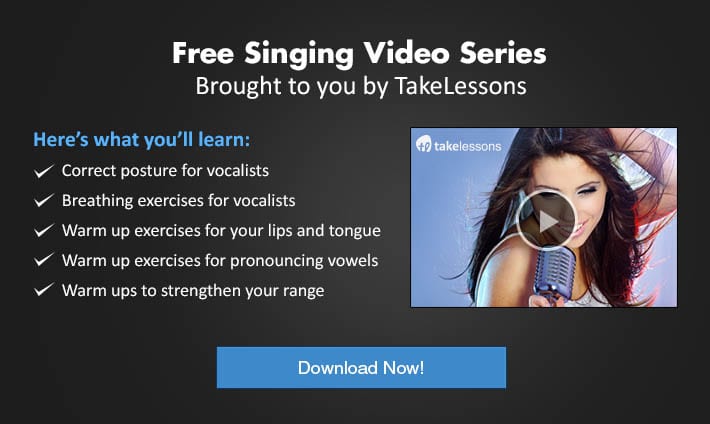 The great thing about being a singer is that you can use your voice, words and stage presence to convey emotions, which some other musicians don’t have the ability to do. So how can you make sure you’re expressing yourself to your full potential? Read on for these great tips and exercises from Nashville teacher Lyn C.:
The great thing about being a singer is that you can use your voice, words and stage presence to convey emotions, which some other musicians don’t have the ability to do. So how can you make sure you’re expressing yourself to your full potential? Read on for these great tips and exercises from Nashville teacher Lyn C.:
As someone who has experience in the classroom and private studio, I find myself wondering where all that enthusiasm escapes to when it’s time for my students to sing. They excitedly share what they did over the weekend, and then sing the folk song “Cindy” like it’s Cindy’s funeral.
To help all of the singers out there, I would like to share a few ideas that have energized and inspired my students (whether it’s by laughing at what a weirdo their teacher is, or taking the point I’m making to heart).
1. Sing as though you were telling a story to a 3 year old.
This was one of my favorite strategies as we prepared for the Christmas concert last year. I asked the Kindergarten students if they had any younger siblings, then, if those children could pay attention for very long. We had a short discussion about ways to keep someone interested in what you are saying and I equated it to singing their songs. They added arm movements, facial expression, word stress and articulation. This works for all ages (even my church choir!), but when you make it relevant to their lives, there is a layer of sincerity that perhaps wasn’t there before.
2. Video record
Sometimes singers think they’re emoting, but it just won’t translate on stage. Record the song, as if it is the actual performance. Take notes (both positive and negative) about how you can improve or be more expressive. When discussing, always start with the positive!
3. Audio record
If a video recording is not possible, you can still learn from just the audio. I record my students singing the song immediately following warm ups, we work on it (recording or not), and then sing it again later in the lesson. I find that when a student emotes, the sound is better, too!
4. Mirror, mirror
Looking at yourself in the mirror as you sing makes it easy to see your energy level. Most voice teachers have a mirror in their teaching space – I would recommend getting one if you don’t already have one! This gives you quick visual feedback, and you can see how much or little you’re doing.
5. Pick a card, any card
This works best with a song you have memorized. Have your teacher write emotions on some note cards. Furious, overjoyed, excited, ennui, restless, crestfallen, etc… just avoid happy and sad (boring!). Your teacher can hand you a card and ask you to sing the verse according to the emotion card. When you’re pushed outside the “expected” emotion, it will be more accessible for you to return to the real feeling of the song.
6. Play theater games
7. Speak text
Have your student read/recite the text in a most dramatic fashion. Demonstrate what it might look/sound like so the student feels more comfortable exploring the possibilities.
8. Expressive warm ups
Once you’re familiar with warm ups to use, try telling a story with only “ah.” Teachers should have different scenarios in mind in case students need some direction. Use the cards from idea 5.
9. Body and face warm up
Try eyebrow pushups. Make your face as wide as possible. As tall as possible. Stretch to a place you haven’t reached yet. Isolate each limb and lengthen/contract as much as possible. When you see and feel how much your body can do, you are more likely to use that forgotten space.
10. Encourage exploration!
Make sure you know that part of being a singer is making artistic choices. Some are more correct than others. But how will you ever know if you don’t try? If nothing else, we now know which gestures, phrasing and facial expressions to omit in performance.
Readers, do you have any methods to add to this list? Leave a comment below, or stop by our Facebook page to join our community!
 Lyn C. teaches piano, singing, Broadway singing, music theory, opera voice, speaking voice, and acting lessons to students of all ages in Nashville, TN. With her Master’s degree in Music Education, Lyn joined the TakeLessons team in July 2012 with experience in both the classroom and the studio. Sign up for lessons with Lyn, or visit TakeLessons to search for a teacher near you!
Lyn C. teaches piano, singing, Broadway singing, music theory, opera voice, speaking voice, and acting lessons to students of all ages in Nashville, TN. With her Master’s degree in Music Education, Lyn joined the TakeLessons team in July 2012 with experience in both the classroom and the studio. Sign up for lessons with Lyn, or visit TakeLessons to search for a teacher near you!
Photo by ErnestDuffoo.
Suzy S.
